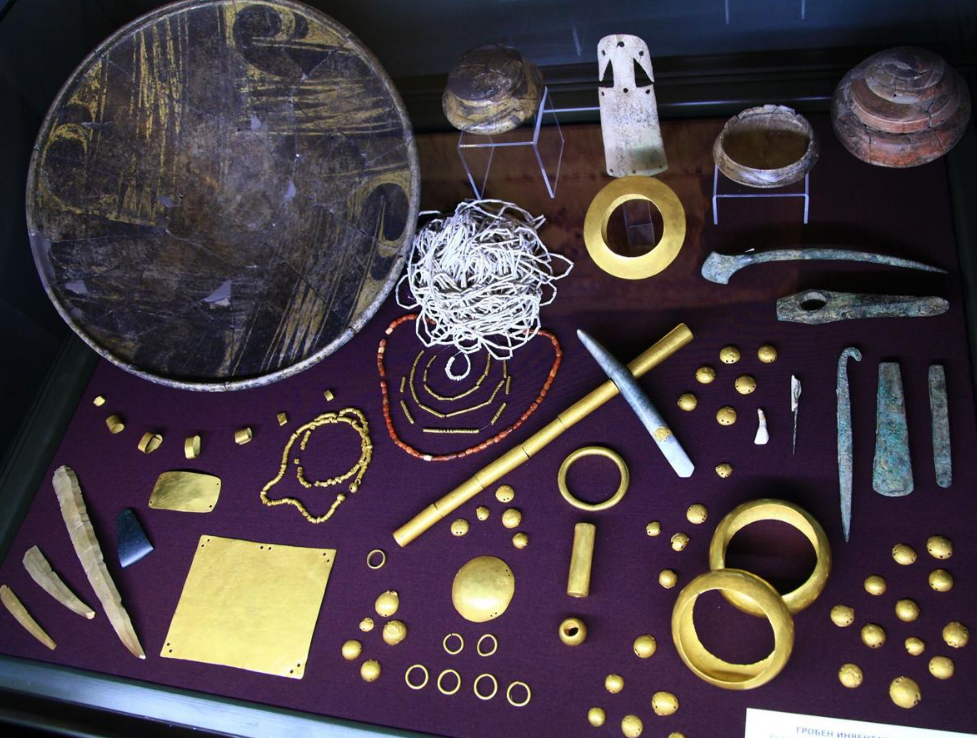The Varna Necropolis, situated along the Bulgarian Black Sea coast, stands as the site where the “Oldest Gold of Mankind” was discovered. In 1972, during the excavation of Varna’s industrial zone, an accidental yet remarkable archaeological find emerged. The Necropolis is located approximately 4 km from the city center and half a kilometer from Lake […]
The Varna Necropolis, situated along the Bulgarian Black Sea coast, stands as the site where the “Oldest Gold of Mankind” was discovered. In 1972, during the excavation of Varna’s industrial zone, an accidental yet remarkable archaeological find emerged. The Necropolis is located approximately 4 km from the city center and half a kilometer from Lake Varna. Scholars believe its construction dates back to the period between 4,600 BC and 4,200 BC, showcasing an array of historical treasures.
This burial ground contains about 300 graves, with grave 43 being the most notable. Holding the remains of an individual of high status, this grave was adorned with an abundance of treasures. In fact, the gold found in this single grave surpassed the total amount discovered in all other archaeological sites from that era combined.

We frequently discuss early and ancient civilizations, such as those that flourished in Mesopotamia, Egypt, and the Indus Valley, which significantly shaped the course of human history. However, there is limited awareness about the enigmatic community that inhabited the shores of the Black Sea in what is now modern-day Bulgaria around 7,000 years ago. Archaeologists refer to this civilization as the Varna Culture.
The Varna Culture was initially perceived as small and insignificant until evidence emerged, demonstrating that it was, in fact, a highly developed culture that predates the civilizations of Mesopotamia and Egypt. Discoveries made at the Varna Necropolis indicated that it was the first known culture to produce artifacts made of gold. This necropolis stands as the largest prehistoric burial ground in southeastern Europe.

The Varna people occupied a strategically advantageous position, situated between the East and the Western world. On one side, they had access to the Black Sea, facilitating trade with neighboring regions and beyond. On the other side, trade routes opened up opportunities for commerce with the entire Mediterranean region. Consequently, Varna evolved into a crucial trading center.
They amassed significant wealth, particularly among craftsmen working with gold and copper, contributing to the development of a well-organized society dominated by metallurgists, merchants, and farmers—a rudimentary class system. This laid the foundation for the emergence of a potent and influential culture that would leave a lasting impact across Europe for millennia.
Prior to 1972, artifacts from the era of the Varna Culture were limited to tools, vessels, utensils, and figurines crafted from materials like stone, flint, bone, and clay. However, the revelation of the Varna Necropolis by archaeologists Mihail Lazarov and Ivan Ivanov in 1972 provided a paradigm shift in how this remarkable civilization was perceived.

Within the 300 graves of the necropolis, archaeologists discovered over 22,000 unique artifacts. This extensive collection includes more than 3,000 golden artifacts, equivalent to 6 kilograms of pure gold. Additionally, there were numerous high-quality copper, flint, and stone tools, along with jewelry, shells from Mediterranean mollusks, pottery, obsidian blades, and beads.
Among the elite burials in the necropolis, one stood out as particularly remarkable. Following the excavation of grave 43, archaeologists concluded that it served as the final resting place of a high-status male, likely a ruler or some form of leader within the society.
This grave stood out as the most opulent among all discovered, not only in Varna Necropolis but in the entire world during that period. The individual was interred with a splendid golden scepter clutched in their hand, symbolizing high rank or spiritual power.

The entire body and its vicinity were adorned with golden items, including necklaces, bracelets, earrings, round-shaped golden ornaments positioned on specific parts of the body, and even a golden plate around the genitals. Alongside the golden artifacts, weapons presumably belonging to this individual were also arranged around the body.
In addition to the wealth of material findings offered by the Varna Necropolis, it provided archaeologists with insights into the hierarchy of this ancient society, their religious beliefs, and intricate burial practices. Notably, there were distinct burial practices for males and females, with males laid out on their backs, while females were placed in the fetal position. Another intriguing discovery pertained to a specific type of grave.
Certain graves did not contain skeletons; instead, they were solely filled with various items. These symbolic graves, identified as cenotaphs, were among the richest in gold and treasures. They included masks crafted from clay and gold amulets shaped like women, positioned beneath the mask, symbolizing the neck of the buried individual.


The amulets symbolize pregnancy and fertility, suggesting their intended purpose for women. The vacant graves also contained a copper pin, a flint knife, and a spindle whorl.
This further indicates that the symbolic graves were created either for women or as an offering to a deity representing the feminine principle. The reason why these graves were devoid of human remains remains a mystery.

The Varna civilization, lacking direct descendants, likely underwent assimilation into other surrounding European and Asian cultures during the centuries of upheaval in the region.
Hot news:
Hot news:
News
Alexa Bliss spotted training; looks in incredible shape ahead of WWE return
Alexa Bliss has been out of in-ring action for well over a year. [Image credits: wwe.com] Alexa Bliss was spotted training at the gym during her hiatus from WWE in a recent Instagram story. It has been more than a…
Rhea Ripley reacts to a fan who tried to touch her at WWE event
Rhea Ripley has a tough Road to WWE WrestleMania this year. The Women’s World Champion first faces Nia Jax in Australia, and, if she survives The Irresistible Force, she will go on to defend her belt against the winner of…
Stephanie McMahon allegedly got pis*ed at WWE veteran on a flight
Stephanie McMahon had an argument with a WWE veteran on a plane, as per the latter’s comments. Greg Gagne had a brief stint with WWE in 2006 and worked as the OVW booker. He was let go by the promotion…
“Pirates of the Caribbean” will no longer have iconic Captain Jack Sparrow
In a recent interview with Variety, famous producer Jerry Bruckheimer shared about the future of the two popular film franchises he is behind, Top Gun and Pirates of the Caribbean. As for Top Gun, Bruckheimer said part 3 of the…
Johnny Depp’s relaunch REVEALED: Truth about reprise of Captain Jack Sparrow role in Pirates Of The Caribbean reboot… the status of his romance with Amber Heard trial lawyer Joelle Rich… and plans for actor’s own brand of rum
The cheekbones are back. As is a languidly stylish and much shorter haircut. And while Johnny Depp retains that trademark rough-cut and tattooed charm, the excessively scruffy – perhaps even grubby – look of recent months seems to be well past. Friends explain…
Johnny Depp almost lost the role of Jack Sparrow to this actor: He holds the world record and is also the “original” of the captain!
This is the male actor representing the Jack Sparrow role model played by Johnny Depp. As the “chameleon” of the Hollywood film industry, Johnny Depp has many familiar roles, leaving many impressions on the audience. But certainly the image of mischievous and…
End of content
No more pages to load























